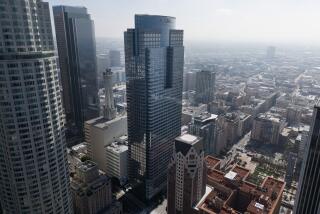Scientists Troll Puget Sound for Clues to Earthquake Risks : Northwest: Geologists seek to pinpoint time of the next big jolt. Last one occurred about 1,000 years ago.
SEATTLE — Earthquake researchers are trolling the waters of Puget Sound--not for fish, but for clues to when the next Big One might hit.
It’s been a long time.
A 7-magnitude quake about 1,100 years ago along the Seattle Fault, one of at least six shallow faults beneath Washington’s inland marine waters, thrust land upward more than 23 feet in some areas and dropped 200-acre chunks of forest into Lake Washington and the sound.
Samuel Y. Johnson, a sedimentary geologist at the U.S. Geological Survey in Denver, and other scientists took reporters aboard a chartered research vessel recently on the fourth day of a 12-day, round-the-clock fault-mapping mission to determine when and where the next severe crustal jolt might come.
“We know the faults are there,” Johnson said. “We don’t know if that’s movement that comes every 1,000 years, every 10,000 years or every 100,000 years.”
Some data may be reported in December, preliminary analysis should be completed in about a year and the final results probably will be ready in another year or so, said Shawn Dadisman, a USGS scientist from Menlo Park, Calif.
A similar time frame applies to complementary University of Washington research on massive landslides triggered by prehistoric quakes in the region, oceanographer Mark Holmes said.
*
Federal funds are covering the cost, about $25,000 for the waterborne mission, $250,000 for the overall quake-mapping project and about $275,000 for the slide studies and risk assessment, Holmes and Johnson said.
“It’s important to know because the places where up to a million cubic yards of shore suddenly cut loose in the past are some of the most heavily urbanized areas in the Puget Sound area today,” Holmes said.
Both projects focus on quakes caused by strain within the upper part of the Earth’s crust, within about 12 1/2 miles of the surface.
A quake of about 5 magnitude beneath the sound about 10 miles south of Seattle on Jan. 28 apparently occurred 9 to 12 miles down, near the bottom of the Seattle Fault, Johnson said.
The strongest quake in the region this century, a 7.1 shocker in 1949, was much deeper, caused by slippage of the Juan de Fuca Plate below the North American Plate.
Some geologists believe quakes of 8 or 9 magnitude could occur along the Cascadia subduction zone off the Pacific Northwest Coast, where the Pacific Plate plunges beneath the Juan de Fuca Plate.
*
The Seattle Fault and other upper-crust quake zones were identified in maps drawn by petroleum companies as part of a fruitless effort to find oil-bearing geological formations in the 1960s and early ‘70s, Johnson said.
Those maps went too far down and thus were on too big a scale to show geologically recent quake activity.
The current research allows analysis within tens of centimeters--a centimeter is about four-tenths of an inch--indicating the frequency of quakes of given intensities and the direction in which different layers of rock are thrust.
Underwater sediments provide the most clear record of recent quakes, Johnson said.
In the bridge of the 120-foot Robert Gray, built for the Army Corps of Engineers to chart ocean depths along the West Coast in 1936, images of sedimentary layers appear on several of the seven computer monitors.
As the vessel chugs southward along the shipping channel east of Bainbridge Island, passing inbound freighters and ocean-going tugs pulling container-laden barges bound for Alaska, the squiggles also appear on three paper printouts, one showing depths to about six-tenths of a mile, another to 330 feet and the third to 132 feet. The information is stored digitally for later analysis.
One printer shows two parallel charts produced from different sets of sound waves bouncing off the rock. One set of waves is emitted by a device in which two plates are driven together between a pair of pontoons, producing a noise halfway between a clap and a pop every half-second.
Farther back from the stern, a white buoy bounces upward as air guns are fired downward in the water every 41 1/4 feet, about once every 10 seconds, producing the second set of sound waves.
Underwater microphones to detect the returning echoes trail more than 600 feet behind the vessel, marked by a series of buoys and linked to the bridge by electronic cable.
Jellyfish, seaweed, bits of wood and pieces of plastic coffee cups sometimes collect in the pontoon-mounted sounding device, creating air pockets that deflect the sound waves.
Pleasure boaters occasionally ignore, miss or fail to understand posted warnings and cross the trailing lines, and special care is needed when the mapping runs cross shipping lanes, Dadisman said.
To hold down costs, operations are conducted 24 hours a day. Towels were mounted inside one set of windows, and a torn slip of yellow paper attached to the door with duct tape bore the handwritten message: “Crew sleeping--please do not disturb. Management.”
In California, the San Andreas and other faults are more visible because of the drier climate. Mapping is harder around Puget Sound because of lush vegetation and complex geology, Dadisman said.
More to Read
Sign up for Essential California
The most important California stories and recommendations in your inbox every morning.
You may occasionally receive promotional content from the Los Angeles Times.










